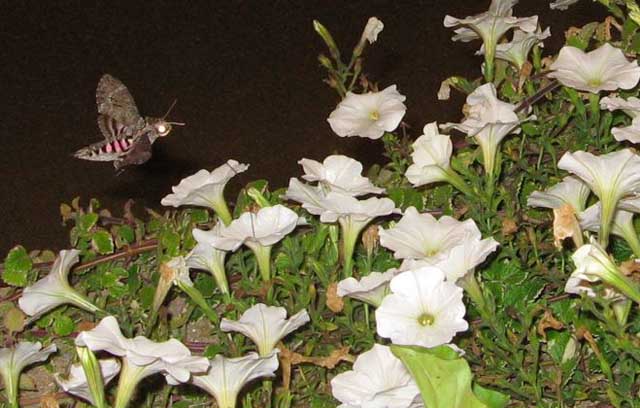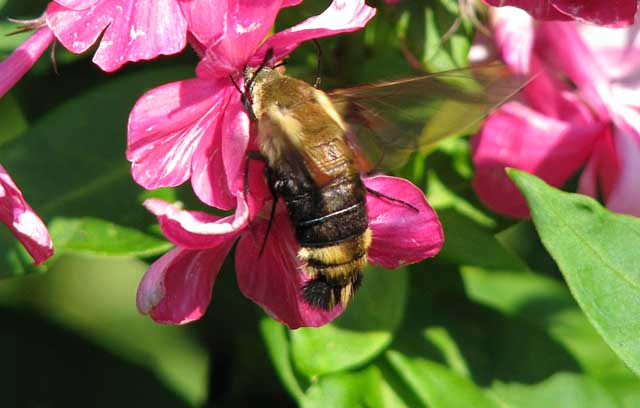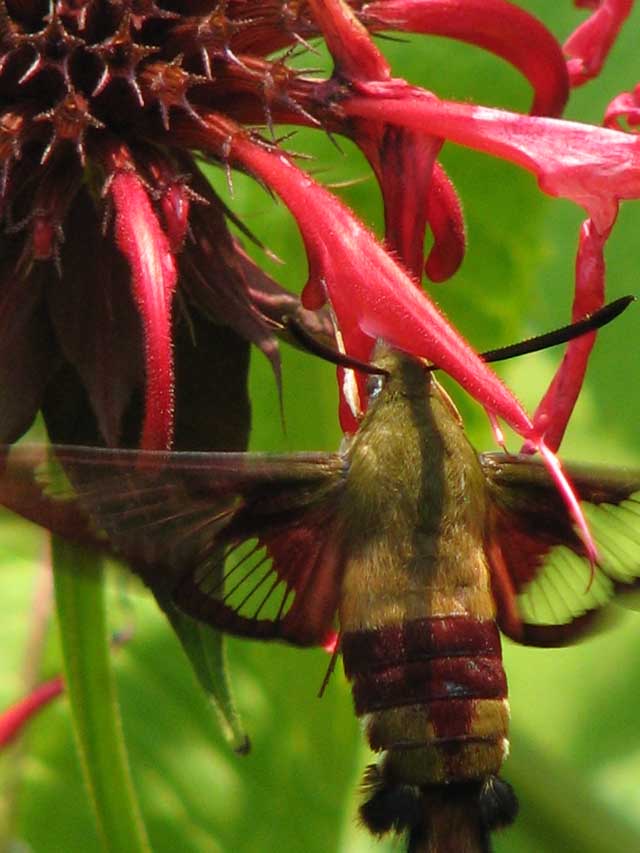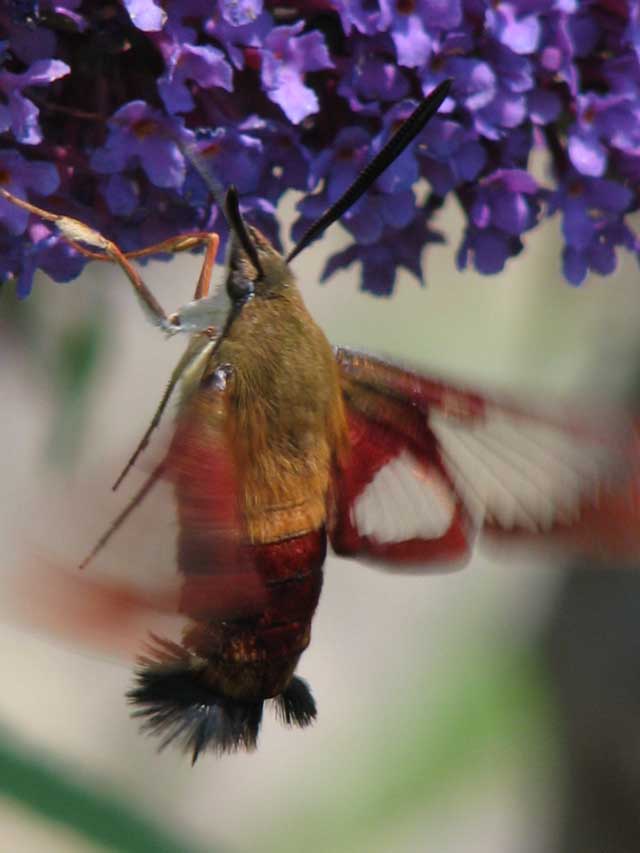Sphinginae subfamily
Sphingini tribe:
 |
Pink-spotted hawkmoth -- (Agrius cingulata) WO/ABC
stray
This moth is a very strong flier, but would only make its way to
Broome County as a rare fall stray. There are not too many records from
New York state, but records exist for NJ and CT.
|
Agrius cingulata, Binghamton, October 15, 2008, Anne B. Clark, Ph.D.
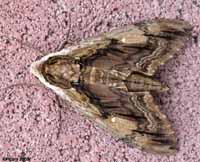 |
Ceratomia amyntor USGS,
the Elm Sphinx or Four-horned Sphinx
This moth is officially recorded in Broome County.
Larvae feed on Elm (Ulmus), birch (Betula), basswood (Tilia), and
cherry (Prunus). |
 |
Ceratomia undulosa
USGS/KAW 2005, the Waved
Sphinx
This moth is recorded in Broome County. I have seen them as far north as P.E.I. in
eastern Canada, and took them in New Jersey.
It is named for the
wavy lines on the forewings. |
Ceratomia undulosa, May 30, June 5, July 17, 2005; May 27, 2006;
June 7, 2007, Endicott,
Karl A. Wilson
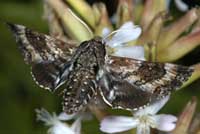 |
The upperside of the forewing is dark brown with a dusting of white scales. Some moths have patches
of reddish or yellowish brown on the wings.
|
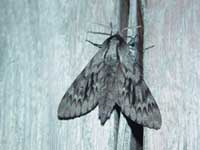 |
The upperside of the forewing is gray with heavy black bands. The upperside of the hindwing is
brownish gray with no markings. The underside is very plain.
Larvae of this small hawk moth feed on pines.
|
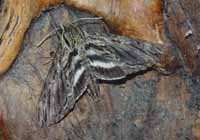 |
Lintneria eremitus WO, the
Hermit Sphinx.
The upperside of the forewing is gray-brown with wavy lines, black dashes, and one or two small white spots near the center of the costa. The upperside of the hindwing is
black with two white bands and a triangular black patch at the base. Note the golden hair on the thorax.
|
 |
Manduca quinquemaculatus
WO,
the Five-spotted Hawkmoth.
The moth abdomen usually has five but sometimes six pairs of yellow
bands. The upperside of the forewing is blurry brown and gray. The
upperside of the hindwing is banded with brown and white and has two
well-separated median zigzag bands.
|
 |
This species is not recorded in Broome County.
If you grow tomatoes, however, you have probably encountered it.
Larvae get very large and can strip a tomato plant.
|
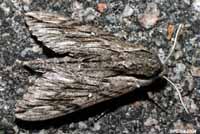 | The upperside of the forewing is gray with indistinct black and
white markings. There is a series of black dashes
from the base to the tip, and a small white cell spot. North of
normal range!
|
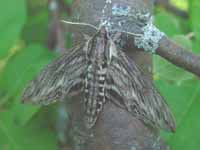
|
Sphinx canadensis
WO,
Sphinx canadensis, the Canadian Sphinx, is not common, and is not
often reported anywhere,
but it might be present in Ontario County as it is reported from
southern Ontario, Canada.
Larval hosts are white ash (Fraxinus americana) and blueberry
(Vaccinium).
|
 |
Sphinx chersis
WO, the Northern Ash Sphinx or Great Ash Sphinx
This species might present but may not
be common. Larval hosts are ash, lilac, privet, cherry, and quaking aspen.
|
 |
This species is officially reported in Broome County. We have them
on P.E.I., but I do not see them nearly as frequently
as I see the other Sphingidae. |
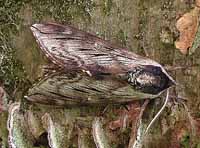 |
Sphinx gordius
WO,
Apple Sphinx:
Colouration & markings highly variable from one specimen to another. Fw fringes mostly black with some white; those on hw mostly white
with a few black patches.
Fw upperside ranges from brown with black borders through brownish gray with paler borders to pale gray with no borders.
Dashes, submarginal line, & cell spot usually weak.
|
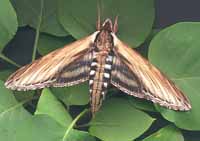 |
The lower forewings are predominantly brownish-yellow with a fairly wide dark bar along the inner margin. At rest the wings hug the body,
giving the moth a long slender look.
|
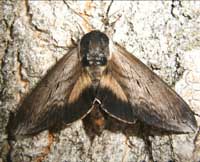 |
Sphinx luscitiosa
WO,
the Canadian Sphinx or
Clemen's Sphinx
This one is reported from Suffolk and Richmond and from
northeastern New Jersey and might be present in Broome County.
|
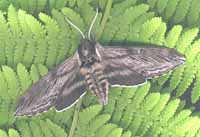 |
If you have blueberries in the woods, then you might have the Poecila Sphinx.
They are pretty common here on Prince Edward Island, but don't fly
too far south of Massachusetts, being replaced by Sphinx gordius
in Connecticut. Questionable.
|
Smerinthini Tribe:
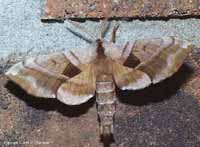 |
This moth is fairly widely reported to the north, east, south and west
of Broome County.
This is the first Sphinx species I reared as a boy in New Jersey.
See the file for the female; she is different.
|
Amorpha juglandis, Endicott, May 16, 2010, Karl A. Wilson
 |
Pachysphinx modesta
WO/KAW,
the Modest Sphinx or Poplar Sphinx
This moth is now recorded in Broome County, and should be found there
near poplars and willows.
They are common on Prince Edward Island.
|
Pachysphinx modesta, June 9, 2007, Karl A. Wilson
 |
Named for the dull grey-blue spot (minus dark pupil) in the hindwing,
this moth has a wide distribution and is probably common in Broome
County.
I regularly see them on Prince Edward Island, and they are reported
as far south as Florida. |
 |
Paonias myops WO/KAW 1979,
the Small-eyed Sphinx
Named for the small eye-spot in the hindwing, this moth has a wide
distribution and is probably common in Broome County.
I regularly see them on Prince Edward Island, and they are reported
as far south as Florida.
|
Paonias myops, July 15, 1979, June 21, 28, 2006, June 3, 2010, Karl A. Wilson
Paonias myops, May 27, 2010, Vestal, Colleen Wolpert
 |
Broome County would be close to the southern limit for this species in New York.
I never saw one in New Jersey. At my home in Montague, P.E.I., Canada, they are quite common.
|
 |
This moth is widely distributed and fairly common.
Along the East Coast, it flies from P.E.I. to Florida. It probably
flies (now confirmed) in Broome County. |
Smerinthus jamaicensis: Karl A. Wilson:
August 16, 2005
Macroglossinae subfamily
Dilophonotini tribe:
See Hemaris comparison to help distinguish
the next three species.
 |
Hemaris thysbe
USGS/KAW 1979/CG, the Hummingbird Clearwing.
This interesting day flier is reported in Broome, and
is widely reported to the north, east, south and west.
They are widely distributed in the east from P.E.I. to Florida.
Note inward projection along inner edge of the forewing outer burgundy band.
|
Hemaris thysbe, July 28, 1979, Karl A. Wilson
Hemaris thysbe, Endwell, July 20, 2008, Cindy Girard
 |
Hemaris diffinis USGS/CG, the
Snowberry Clearwing or Bumblebee Moth
This moth is widespread and has been recorded in Broome County and
in northwestern N.J. and southeastern N.Y. and Connecticut.
|
Hemaris diffinis, Endwell, July 27, 2008, Cindy Girard
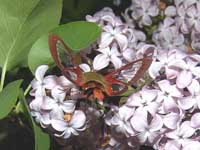 |
Hemaris gracilis WO, the
Slender Clearwing or Graceful Clearwing
This day-flying moth is less common and has not been recorded in
Broome, but has been seen due east, south and west.
Note smooth contour of inner edge of the forewing outer burgundy band.
|
Philampelini tribe:
 |
This moth is not reported for Broome, but it is fairly often reported
along the coast from southern New Jersey
to central Maine.
Note the differences between this moth and the Pandorus Sphinx. |
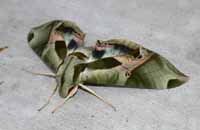 |
If you have Grape or Virginia Creeper nearby, then you probably have
this species.
I often get asked to identify larvae from areas not
previously reported. |
Macroglossini tribe:
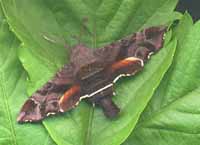 |
This day flier is widely distributed. If you have Virginia Creeper, you
probably have the Nessus Sphinx. It is now reported from
Broome County by KAW.
Two bright, distinct, narrow yellow
bands are often visible on the abdomen.
|
Amphion floridensis, June 3, 1990, Karl A. Wilson
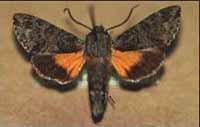 |
This species is rarely recorded in the U.S., but there are sightings in the east
from Florida, South Carolina, New Jersey, New York, Massachusetts and
New Hampshire.
There are no reports from Broome. Very questionable/unlikely!
|
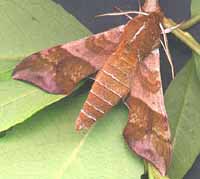 |
They are common in New Jersey and common
here on Prince Edward Island.
You will often see this species listed as Darapsa pholus,
especially in older literature.
It is confirmed for Broome County.
|
Darapsa choerilus, July 15, 1979; June 14, 2005, Karl A. Wilson
 |
Darapsa myron
WO/KAW 2005, the Virginia Creeper Sphinx or the Grapevine Sphinx
This moth is now recorded by KAW for Broome County
It is widely reported as far north as southern Maine. If you have the
foodplants indicated in the common names, you probably have this
species nearby.
|
Darapsa myron, July 28, 2005, Karl A. Wilson
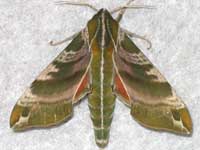 |
If you have hydrangea growing near a stream, then you may have the
Hydrangea Sphinx.
It has not been reported in Broome, but likely
is present although uncommon.
|
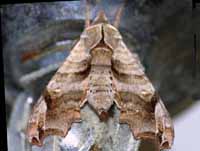 |
Deidamia inscriptum
KAW 1988, 2005, 2006, 2007,
the Lettered Sphinx
This species has been recorded in Broome County and in surrounding
areas.
It probably flies earlier in the season than any of the
other Sphingidae in Broome County.
|
Deidamia inscriptum:
Karl A. Wilson, Endicott, reports sightings May 3, 1988,
April 29, 2006; April 3, 2006, May 9, 2006; May 8, 2007
 |
Hyles gallii
WO/KAW/PC, the Bedstraw Hawk Moth
or Gallium Sphinx
The forewing is dark brown with a wide, slightly irregular, cream-coloured transverse line. The outer margin is grey. There is a bright pink band on the
hindwing.
|
Hyles gallii, June 12, 1980, Karl A. Wilson
Hyles gallii, Old Newark Valley Road, Endicott, July 31-early August, Paula Carman.
 |
Hyles lineata WO/KAW, the White-lined Sphinx
This species is not reported from Broome County. It flies across
southern New York and has strong migrating tendancies.
There are records from New Hampshire and Maine. |
Hyles lineata Vestal, September 15, 2010, Karl A. Wilson.
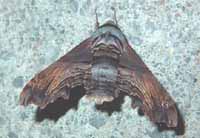 |
This moth is very much under reported across the United States. It
is a rapid day flier so is probably not in too many collections.
Grape is a popular larval host. It is confirmed for Tompkins and now
May 9, 2006 for Broome KAW.
|
Sphecodina abbottii May 9; June 3, 2006; June 6, 2007, Karl A. Wilson.
|
|
